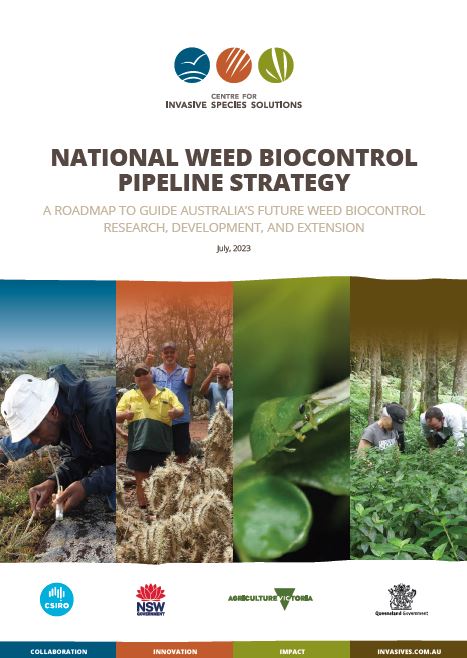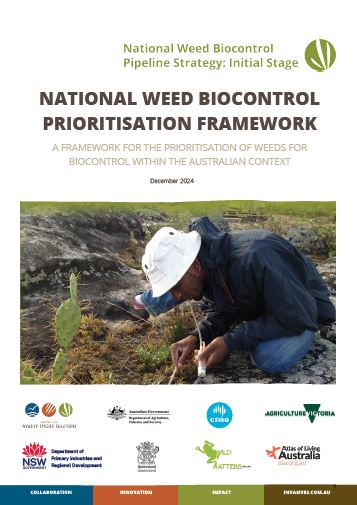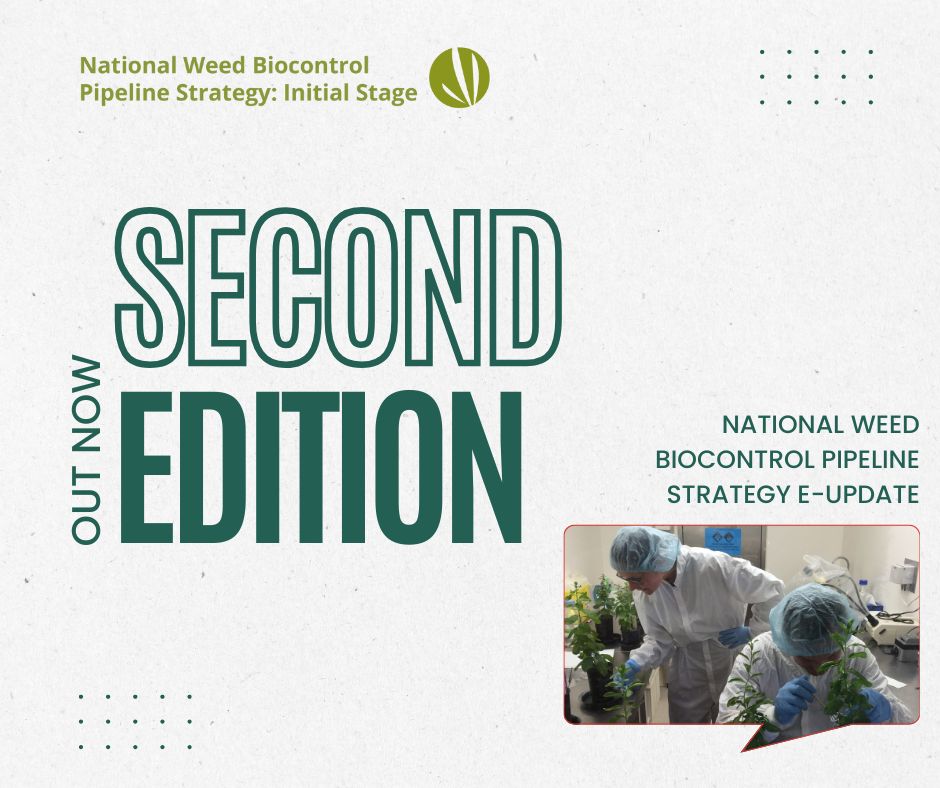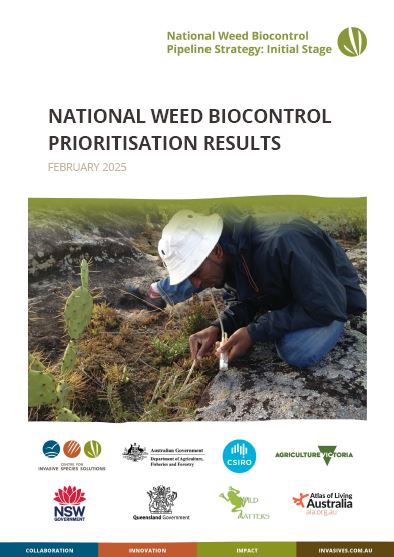What is weed biocontrol?
Weed biocontrol is a powerful tool to mitigate emerging and established weed threats at the national landscape scale.
Biocontrol is the practice of managing a weed by the deliberate introduction of one or more natural enemies (biocontrol agents) sourced from the weed’s native range. Biocontrol is cost-effective because it can be used at scale and can help in the management of herbicide resistant weeds.
Australia’s success stories in weed biocontrol include prickly pear, Paterson’s Curse and bridal creeper.

Contents on the biocontrol hub
- National Weed Biocontrol Pipeline Strategy
- Candidate weeds for biological control including endorsed species
- Active weed biocontrol programs (coming soon)
- Citizen monitoring of weed biocontrol programs
- Links and resources
National Weed Biocontrol Pipeline Strategy
The National Weed Biocontrol Pipeline Strategy was developed by the Centre for Invasive Species Solutions and the CSIRO, working with NSW, Queensland and Victorian government weed biocontrol experts.
Following a public consultation phase, the Strategy was endorsed by the Environment and Invasives Committee in July 2023. The Strategy aims to guide Australia’s future weed biocontrol research, development and extension activities for priority weeds at a national scale.
Following a competitive process, the Centre and its partners have been engaged by the Department of Agriculture, Fisheries and Forestry to deliver the initial phase of work by early 2025. Project scope includes establishing a Weed Biocontrol RD&E Alliance, developing a National Weed Biocontrol Prioritisation Framework, delivering a National Weed Biocontrol Priority List for Candidate Weeds for EIC consideration, and estimating implementation costs.
A nomination process for high threat weeds for assessment through this process has now closed. Keep coming back to this page for project updates.
About the project
Read the project reports, fact sheet and subscribe to the e-Updates to keep up with all the latest.

Candidate weeds for biological control including endorsed species
Successful biological control is one of the most effective ways to control weeds across the landscape in the long term. Over many years governments have worked together to determine weeds which are suitable for biological control, this currently being through the Environment and Invasives Committee. It is important to determine whether there is any significant use of a weed (as a cultivated or wild plant) that would likely preclude biological control being used against it, before investing in a lengthy and comprehensive research in biological control agents.
The introduction of a potential biological control agent is separately assessed under the Biosecurity Act 2015 and the Environment Protection and Biodiversity Conservation Act 1999. The assessment involves comprehensive host testing (testing what plants the biological control agent will attack) before release.

Endorsed species
Find weed species endorsed for biological control by intergovernmental committees below, including two cases where formal approval as a target weed for biological control was obtained under the Biological Control Act 1984.
Access the current Environment and Invasives Committee procedure for determining candidate weed species and/or control agents for biological control.
Endorsed species current as of October 2023:
A – F
| Scientific Name | Common Name | Year approved | Approval by | Submitting member |
|---|---|---|---|---|
| Ageratina riparia | mistflower | 1983 | AWC | QLD |
| Ambrosia artemisiifolia | ragweed | 1983 | AWC | QLD |
| Andredera cordifolia | Madeira vine | 2007 | NRMSC(13) | QLD |
| Andropogon gayanus | Gamba grass | 2022 | EIC 9 – 2022-02 | COMM/DAFF |
| Asparagus asparagoides | bridal creeper | 1991 | SCA (147) | SA |
| Bryophyllum delagoense | mother-of-millions | 2001 | SCARM (18) | QLD |
| Bryophyllum delagoense x B. diagremontianum | hybrid mother-of-millions | 2001 | SCARM (18) | QLD |
| Cabomba caroliniana | cabomba | 2006 | SCRAM(12) | QLD |
| Calotropis procera | calotrope | 2014 | AWC28 | QLD |
| Cardiospermum grandiflorum | balloon vine | 2019 | EIC – OOS-2019-05 | NSW |
| Carduus nutans | nodding thistle | 1986 | SCA(136) | NSW |
| Carduus pycnocephalus | Italian thistle | 1986 | SCA(136) | NSW |
| Carduus tenuiflorus | slender thistle | 1986 | SCA(136) | NSW |
| Chromolaena odorata | Siam weed | 2010 | AWC 21 | QLD |
| Chrysanthemoides monilifera subsp. monilifera | bitou bush | 1986 | SCA (136) | NSW |
| Cirsium arvense | perennial thistle | 1988 | SCA (141) | VIC |
| Cirsium vulgare | spear thistle | 1988 | SCA (141) | VIC |
| Clidemia hirta | Koster’s curse | 2014 | AWC29 | QLD |
| Conyza canadensis | Canadian fleabane | 2020 | EIC – OOS-2019-009 | QLD |
| Conyza sumatrensis | tall fleabane | 2020 | EIC – OOS-2019-009 | QLD |
| Conyza bonariensis | flaxleaf fleabane | 2017 | IPAC 10 2017 | NSW |
| Cylindropuntia pallida | Hudson pear | 2008 | NBC 2 | QLD |
| Cylindropuntia spp. | cholla cacti, prickly pears | 2013 | AWC 27 | QLD |
| Cyperus aromaticus | Navua sedge | 2020 | EIC – OOS-2020-08 | QLD |
| Delairea odorata | cape ivy | 2018 | EIC 1 2018 | VIC |
| Dolichandra unguis-cati | cat’s claw creeper | 2005 | NRMSC (9) | QLD |
| Echium plantagineum | Paterson’s curse | 1987 | BCA, 1985 + agents | VIC |
| Eichhornia crassipes | water hyacinth | 1976 | AAC (95) | QLD |
| Euphorbia paralias | sea spurge | 2010 | AWC 21 | WA |
G – L
| Scientific Name | Common Name | Year approved | Approval by | Submitting member |
|---|---|---|---|---|
| Genista linifolia | flax-leaved broom | 1998 | SCARM (12) | SA |
| Genista monspessulana | cape broom | 1998 | SCARM (12) | SA |
| Genista stenopetala | Madeira broom | 1998 | SCARM (12) | SA |
| Heliotropium amplexicaule | blue heliotrope | 2001 | SCARM (18) OOS | NSW |
| Jatropha curcas | physic-nut | 1999 | SCARM (13) | – |
| Jatropha gossypifolia | bellyache bush | 1999 | SCARM (13) | – |
| Leucanthemum vulgare | ox-eye daisy | 2020 | EIC – OOS-2020-01 | NSW |
| Lycium ferocissimum | African boxthorn | 2016 | IPAC – OOS-2016-04 | SA |
M – R
| Scientific Name | Common Name | Year approved | Approval by | Submitting member |
|---|---|---|---|---|
| Marrubium vulgare | white horehound | 1991 | SCA (147) | VIC |
| Miconia calvescens | miconia | 2014 | AWC29 | QLD |
| Mikania micrantha | mikania | 2014 | AWC29 | QLD |
| Mimosa invisa | giant sensitive plant | 1983 | SCA (129) | NT |
| Moraea flaccida | one-leaf Cape tulip | 1999 | SCARM (13) | WA |
| Moraea miniata | two-leaf Cape tulip | 1999 | SCARM (13) | WA |
| Nassella neesiana | Chilean needle grass | 2005 | NRMSC (10) | VIC |
| Nassella trichotoma | serrated tussock | 1998 | SCARM (12) | NSW |
| Onopordum acanthium | Scotch thistle | 1988 | SCA (141) | NSW |
| Onopordum acaulon | stemless thistle | 1988 | SCA (141) | NSW |
| Onopordum illyricum | Illyrian thistle | 1988 | SCA (141) | NSW |
| Onopordum tauricum | Taurian thistle | 1988 | SCA (141) | NSW |
| Opuntia robusta | wheel cactus | 1988 | NRMSC15 | SA |
| Parkinsonia aculeata | parkinsonia | 1983 | AWC | QLD |
| Passiflora foetida | stinking passionflower | 2018 | EIC – OOS-2018-17 | WA |
| Pereskia aculeata | leaf cactus | 2019 | EIC – OOS-2019-09 | NSW |
| Phyla cansescens | lippia | 2006 | NRMSC (12) | QLD |
| Polygala myrtifolia var. myrtifolia | polygala | 2018 | EIC 1 2018 | WA |
| Prosopis spp. | mesquite | 1991 | SCA (147) | WA |
| Reseda lutea | cutleaf mignonette | 1995 | SCARM (5) | SA |
| Reseda phyteuma | rampion mignonette | 1995 | SCARM (5) | SA |
| Rubus fruticosus agg. | blackberry | 1985 | BCA, 1985 no agents | VIC |
| Rumex acetosella | sorrel | 1983 | SCA (129) | WA |
| Rumex conglomeratus | clustered dock | 1983 | SCA (129) | WA |
| Rumex crispus | curled dock | 1983 | SCA (129) | WA |
| Rumex obtusifolius | broad leaved dock | 1983 | SCA (129) | WA |
| Rumex pulcher | fiddle dock | 1983 | SCA (129) | WA |
S – Z
| Scientific Name | Common Name | Year approved | Approval by | Submitting member |
|---|---|---|---|---|
| Sagittaria calycina | arrowhead | 2015 | IPAC 04 – 2015 | VIC |
| Sagittaria platyphylla | delta arrowhead | 2015 | IPAC 04 – 2015 | VIC |
| Schinus terebinthifolius | broad-leaved pepper tree | 2018 | EIC 1 2018 | NSW |
| Senecia madagascariensis | fireweed | 1991 | SCA (147) | QLD |
| Senna obtusifolia | sicklepod | 1983 | AWC | QLD |
| Senna tora | sicklepod | 2020 | EIC – OOS-2020-05 | QLD |
| Sida acuta | common wireweed | 1985 | SCA (134) | – |
| Sida cordifolia | flannel weed | 1985 | SCA (134) | – |
| Silybum marianum | variegated thistle | 1988 | SCA (141) | VIC |
| Solanum elaeagnifolium | silverleaf nightshade | 1986 | SCA (136) | VIC |
| Solanum viarum | tropical soda apple | 2017 | IPAC 10 2017 | COMM/DAWR |
| Sonchus oleraceus | common sowthistle | 2017 | IPAC 10 2017 | COMM/DAWR |
| Spathodea campanulata | African tulip tree | 2022 | EIC – OOS -2021-06 | QLD |
| Sphagneticola trilobata | Singapore daisy | 2023 | EIC 12 – 2023 – 07 | QLD |
| Sporobolus africanus | Parramatta grass | 2007 | NRMSC (14) | QLD |
| Sporobolus fertilis | giant Parramatta grass | 2007 | NRMSC (14) | QLD |
| Sporobolus jacquemontii | American rat’s tail grass | 2007 | NRMSC (14) | QLD |
| Sporobolus natalensis & Sporobolus pyramidalis | giant rat’s tail grass | 2007 | NRMSC (14) | QLD |
| Tecoma stans | yellow bells | 2018 | EIC 1 2018 | NSW |
| Tradescantia fluminensis | trad | 2015 | IPAC – OOS-2015-11 | VIC |
| Tribulus terrestris | caltrop | 1989 | SCA (143) | VIC |
| Ulex europaeus | gorse | 1995 | SCARM (6) | TAS |
Key
- AAC – Australian Agricultural Council
- NRMSC – Natural Resource Management Standing Committee
- AWC – Australian Weeds Committee
- BCA – Biological Control Act
- EIC – Environment and Invasives Committee
- IPAC – Invasive Plant and Animal Committee
- SCA – Standing Committee on Agriculture
- SCARM – Standing Committee on Agriculture and Resource Management
The following list displays additional weeds for which biological control programs occurred, which pre-existed the approval processes that have occurred since 1983.
| Weed Target | Common Name | Program recognised as established prior to formal weed approval process |
|---|---|---|
| Acacia nilotica ssp. Indica | prickly acacia | Yes |
| Acanthocereus pentagonus | sword pear | Yes |
| Ageratina adenophora | Crofton weed | Yes |
| Alternanthera philoxeroides | alligator weed | Yes |
| Baccharis halimifolia | groundsel bush | Yes |
| Cryptostegia grandiflora | rubber vine | Yes |
| Cylindropuntia imbricata | chain-link cactus | Yes |
| Cytisus scoparius | Scotch broom | Yes |
| Harrisia bonplandii | harrisia cactus | Yes |
| Harrisia martinii | harrisia cactus | Yes |
| Harrisia tortuosa | harrisia cactus | Yes |
| Lantana camara | lantana | Yes |
| Lantana montevidensis | creeping lantana | Yes |
| Mimosa pigra | mimosa | Yes |
| Opuntia aurantiaca | jointed prickly-pear | Yes |
| Opuntia dillenii | spiny pest pear | Yes |
| Opuntia monacantha | drooping prickly pear | Yes |
| Opuntia streptacantha | erect prickly pear | Yes |
| Opuntia stricta | erect prickly pear | Yes |
| Opuntia tomentosa | velvet tree pear | Yes |
| Parthenium hysterophorus | parthenium weed | Yes |
| Pistia stratiotes | water cabbage | Yes |
| Salvinia molesta | giant salvinia | Yes |
| Sida rhombifolia | arrowleaf sida | Yes |
| Xanthium strumarium (syn. X. occidentale) | Noogoora burr | Yes |
The first biological control approved listing was implemented by the Australian Weeds Committee. The current 2019 Environment and Invasives Committee procedure is available in PDF format.
Active weed biocontrol programs
Coming soon
Citizen monitoring of weed biocontrol agents
Monitor biocontrol agent releases and record field observations of agent occurrence using the Australian Biocontrol Hub, managed by the Atlas of Living Australia: https://biocollect.ala.org.au/biocontrolhub

Links and resources
Find the full range of biocontrol resources, from economic impact reports to research papers and control manuals.

















